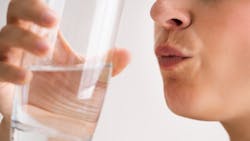The evidence on preoperative mouthwash efficacy
ANSWER: It has been estimated that there are more than 1,000 different microbes, including bacteria, yeasts, viruses, and fungi that reside in the oral cavity.¹ Many of the early infection control studies focused on microbial control of aerosols and targeted bacteria that could be captured on filters. In 1993, Fine, et al. published a study in the Journal of the American Dental Association titled, “Reducing bacteria in dental aerosols: Preprocedural use of an antiseptic mouthrinse.” Their conclusion was that following a 30-second prerinse of essential oil mouthrinse, airborne microbes were reduced by 93.6%.² While this study helped to strengthen the importance of preprocedural rinsing, it did not consider viruses. Controlling viruses contained in aerosols from the oral cavity has become a new area of focus.
Until recently, infection control studies concentrated on large microbes, such as bacteria. Viruses are much smaller than bacteria and are more difficult to culture. The SARS-CoV-2 virus is from 50 to 140 nm, whereas bacteria can range from 400 nm to 3 µm (3 micrometers, which is 3,000 nm). Benedette Cufarri, MSc, science writer and author of “The size of SARS-CoV-2 and its implications,” states, “. . . a dust mite is typically 200 µm in size. If we [compare] a 100 nm SARS-CoV-2 particle, this makes the dust mite 2,000 times larger.”³
Another problem is that most of the studies designed to look at whether a medicament can inactivate any microbe, virus or otherwise, have been conducted in vitro under sterile laboratory conditions. The oral cavity is anything but sterile, and saliva presents many challenges that can interfere with a medicament’s ability to kill microbes. Saliva has the ability to neutralize certain antimicrobials, thus reducing their ability to kill pathogens. Saliva has also been shown to cover, coat, and protect viruses.
Just a short time after the SARS-CoV-2 virus was isolated, researchers believed that hydrogen peroxide could potentially inactivate or possibly kill the virus, especially since this virus is affected by oxidation. However, in more recent studies, researchers have found that hydrogen peroxide mouth rinsing leads to no significant reduction of viral load. For clinical relevance, the researchers stated, “The recommendation of a preprocedural mouthrinse with hydrogen peroxide before intraoral procedures is questionable and thus should not be supported any longer, but strict infection prevention regimens are of paramount importance.”⁴
Another popular antimicrobial is chlorhexidine gluconate (CHX). The antiplaque efficacy of this medicament is well-established. However, CHX has not been found to be effective against the SARS-CoV-2 virus. A study by de Assis et al. found that CHX was ineffective for inactivating coronaviruses.⁵
One of the most potent antiviral agents is povidone-iodine. Several studies have demonstrated that povidone-iodine has a higher virucidal capability than other commonly used antiseptic agents.⁶ However, some negatives of using povidone-iodine include unpleasant taste, potential staining of composite restorations, and potential for allergic reactions in patients who are sensitive to iodine.
Recently, the Institute of Antiviral Research at Utah State University conducted a study that compared the antiviral efficacy of four oral rinses. Those rinses were 1.5% hydrogen peroxide, 0.2% povidone iodine, .12% chlorhexidine gluconate, and a molecular iodine rinse. The only rinse to demonstrate complete effectiveness against the SARS-CoV-2 virus was the molecular iodine oral rinse. It was found to be completely effective within 30 seconds. The other three rinses were only partially effective, even after 60 seconds, the researchers found. Another key finding was that none of the iodine formulations showed any cytotoxicity, whereas hydrogen peroxide and chlorhexidine gluconate did demonstrate cytotoxicity.
A more recent study that was conducted by an independent laboratory (BioScience Laboratories in Bozeman, Montana, advised by TRAC Research) included the clinical challenge of fresh human whole saliva that was collected and pooled from 10 non-COVID-19-infected adult humans. The results showed that in the iodine category, molecular iodine 0.01% showed almost twice the virus reduction as 0.2% povidone iodine, with or without the fresh human whole saliva challenge. The molecular iodine formulation was not substantially affected by the presence of fresh human whole saliva.
One question that comes to mind is, what is the difference between molecular (or free) iodine and povidone-iodine? The component in povidone-iodine that is biocidal is called molecular iodine. The amount of molecular iodine in povidone-iodine is about three parts per million (ppm). Ten percent betadine, a well-known health-care antiseptic, contains about 30,000 ppm total iodine, but only about 3 ppm of that is molecular iodine, which is the only biocidal iodine component. The molecular iodine product is a patented formulation that contains 100 ppm molecular iodine, water, potassium iodate, citric acid, zinc gluconate, flavoring, and sodium saccharin. The unique feature of this patented, pale amber-colored, nonstaining formulation is the 100 ppm molecular iodine (free iodine), which increases its biocidal activity and decreases its toxicity.
As dental professionals, we’ve had to make many changes in our clinical protocol, including temperature checks, masking, gowns, head covering, air purification systems, preoperative rinsing, and high-volume evacuation. Prerinsing is one step in the system of protocols to ensure that the care we render is as safe as possible. Currently, the molecular iodine product is the only commercially available antiseptic rinse that has performed well in controlled testing using the SARS-CoV-2 strain virus in the presence of fresh human whole saliva. Certainly, all types of products used to control clinical cross-contamination need this same type of independent testing under rigorous clinical conditions to validate efficacy against viruses before use with patients.
Editor's note: This article appeared in the July 2021 print edition of RDH.
References
1. ten Cate J. Biofilms, a new approach to the microbiology of dental plaque. Odont. 2006;94:1-9. https://doi.org/10.1007/s10266-006-0063-3
2. Fine DH, Yip J, Fergang D, et al. Reducing bacteria in dental aerosols. Preprocedural use of antiseptic mouthrinse. J Amer Dent Assoc. 1993;124(5):56-58.:doi.org/10.14219/jada.archive.1993.0122
3. Cufarri B. The size of SARS-CoV-2 and its implications. Updated February 15, 2021. Accessed March 23, 2021. https://www.news-medical.net/health/The-Size-of-SARS-CoV-2-Compared-to-Other-Things.aspx
4. Gottsauner MJ, Michaelides I, Schmidt B, et al. A prospective clinical pilot study on the effects of a hydrogen peroxide mouthrinse on the intraoral viral load of SARS-CoV-2. Clin Oral Investig. 2020;24:3707-3713. doi:10.1007/s00784-020-03549-1
5. de Assis MS, Araújo RAAM, Lopes AMM. Safety alert for hospital environments and health professional: Chlorhexidine is ineffective for coronavirus. Rev Assoc Med Bras. 1992;66(9):124-129. doi:10.1590/1806-9282.66.S2.124
6. Bidra AS, Pelletier JS, Westover JB, et al. Rapid in-vitro inactivation of severe acute respiratory syndrome coronavirus 2 (SARS-CoV-2) using povidone-iodine oral antiseptic rinse. J Prosthodont. 2020;29(6):529-533. doi:10.1111/jopr.13209
7. Moskowitz, H, Mendenhall, M. Comparative analysis of antiviral efficacy of four different mouthwashes against severe acute respiratory syndrome coronavirus 2: An in vitro study. Int J Experiment Dent Sci 2020;9(1):1-3.
DIANNE GLASSCOE WATTERSON, MBA, RDH, is a consultant, speaker, and author. She helps good practices become better through practical analysis and teleconsulting. Visit her website at wattersonspeaks.com. For consulting or speaking inquiries, contact Watterson at [email protected] or call (336) 472-3515.
About the Author
Dianne Glasscoe Watterson, MBA, RDH
DIANNE GLASSCOE WATTERSON, MBA, RDH, is a consultant, speaker, and author. She helps good practices become better through practical analysis and teleconsulting. Visit her website at wattersonspeaks.com. For consulting or speaking inquiries, contact Watterson at [email protected] or call (336) 472-3515.
Updated June 30, 2020

